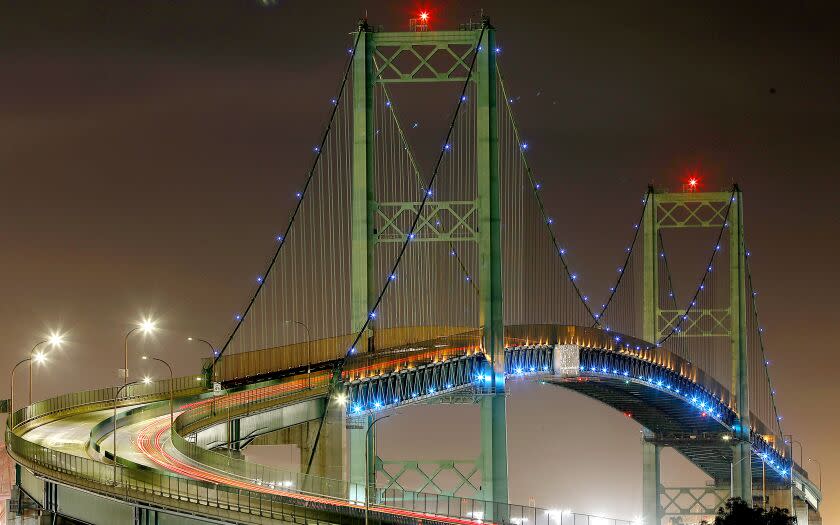Motorists in San Pedro, Long Beach face headaches during repairs to Vincent Thomas Bridge

The 60-year-old Vincent Thomas Bridge in San Pedro is showing its age and needs major repair work, but a restoration project that is sure to create traffic headaches for locals could last nine months to three years, depending on the construction schedule.
The 6,000-foot span bridge connects San Pedro to the west end of Terminal Island, which is home to the Port of Long Beach and Port of Los Angeles. The bridge carries roughly 58,000 vehicles daily, with more than 5,100 heavy trucks, according 2021 data from the California Department of Transportation.
But the years of acting as one of the main arteries to the ports have caused the bridge's concrete to deteriorate, Caltrans said in its project overview plan to replace the bridge's deck or upper layer of concrete. The project is meant to preserve the bridge's structural integrity and overall safety, with a total cost of approximately $706 million for construction, design and other aspects of the project.
The agency carried out a patchwork of repairs to the bridge in 2009 and 2011, but the severity of the deterioration has been increasing.
Caltrans proposes replacing the bridge's concrete because an inspection conducted in 2022 showed the concrete quality has deteriorated from a rating of fair to poor. Parts of the concrete deck are cracking and breaking away, according to Caltrans.
The project is expected to start in 2025, and the construction timeline will vary, depending on the work schedule adopted by the state, according to Caltrans.
The agency could implement several options for the construction phase. Caltrans could order a full bridge closure — with 24/7 work — that would take nine to 12 months. The agency could also try for a partial bridge closure with a limited number of lanes shut down and night work schedules that could span two to three years.
Either way, the project would pose a major inconvenience for residents, employees and truck drivers who use the bridge. Port workers operate on three shifts throughout the day. Motorists who take State Route 47 on the bridge to travel between San Pedro and Long Beach will also be delayed.
"This project will be a major headache for so many people," Los Angeles County Supervisor Janice Hahn said during a May 4 virtual scoping meeting hosted by Caltrans. She requested that Caltrans consider funding a ferry to take workers to Terminal Island and avoid the gridlock on the bridge.
Among the many issues that Hahn said could dog the project are the noise and air pollution created by the traffic that could impact more heavily on residents in the Wilmington neighborhood once the bridge work begins.
"I think we all agree that we need a safe Vincent Thomas bridge, but we have to make sure that this project does not mean more trucks cutting through the community of Wilmington, which they tend to do when there is not a specific route for them," Hahn said.
Ashley Hernandez, a Wilmington resident and organizer with Communities for a Better Environment, said during the scoping session that she worries that the increase in truck traffic could pose a serious risk to pedestrians and local residents. She said that the corridors that already see heavy traffic will become even more dangerous with an influx of heavy trucks snaking their way around residential neighborhoods to freeways and the ports.
"I'm not hyperbolizing when I say people will die," Hernandez said.
San Pedro resident Luis Dominguez said that whenever there is construction on the bridge, the backup in traffic is severe. He advocated for a full bridge closure with the shortest construction timeline.
"Nobody is going to like any of it closed," he said. "My belief is rip the bandage off at once."
Other residents in the Harbor communities expressed frustration about the lack of notice for the project's public comment period. An in-person meeting held in April was attended by only three local residents and others vented their frustration during a May 4 meeting about how Caltrans notified the public.
The agency has extended the window for public comment through May 26. As required by state law, the project will undergo technical studies, and by the end of the year Caltrans will circulate a draft environmental impact report before holding another public meeting to gather more feedback. Studies will continue into 2024, with more public comments included in the report and a final version expected to be released by next Spring, according to Caltrans.
This story originally appeared in Los Angeles Times.

